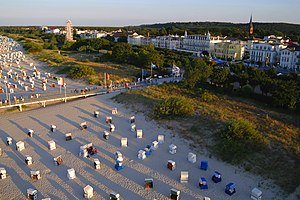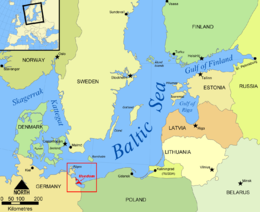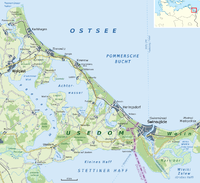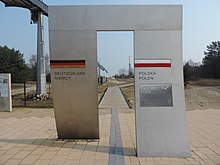Usedom
Nickname: Sunny Island | |
|---|---|
 Beach, dune, and promenade inAhlbeck– a distinctiveseaside resort,typical for the Island of Usedom | |
 Map of the Baltic Sea with the island highlighted | |
| Geography | |
| Location | Baltic Sea |
| Area | 445 km2(172 sq mi) |
| Length | 66.4 km (41.26 mi) |
| Width | 23.9 km (14.85 mi) |
| Coastline | 110 km (68 mi) |
| Highest elevation | 69 m (226 ft) |
| Highest point | Golm |
| Administration | |
Germany | |
| State | Mecklenburg-Vorpommern |
| District | Vorpommern-Greifswald |
| Largest settlement | Heringsdorf,Zinnowitz(settlements),Usedom (town) |
Poland | |
| Voivodeship | West Pomeranian Voivodeship |
| County | Świnoujście(city county) |
| Largest settlement | Świnoujście |
| Demographics | |
| Demonym | Usedomers |
| Population | 76,500 (2012) |
| Pop. density | 172/km2(445/sq mi) |
| Ethnic groups | Poles,Germans |
Usedom(German:Usedom[ˈuːzədɔm],Polish:Uznam[ˈuznam]) is aBaltic SeaislandinPomerania,divided betweenGermanyandPoland.It is the second largest Pomeranian island afterRügen,and the most populous island in the Baltic Sea.
It lies north of theSzczecin Lagoonestuaryof theOderriver. About 80% of the island belongs to the German district ofVorpommern-Greifswaldin the state ofMecklenburg-Vorpommern.The eastern part and the largest city on the island,Świnoujście,are part of the PolishWest Pomeranian Voivodeship.The island's total area is 445 square kilometres (172 square miles) – 373 square kilometres (144 square miles) in the German part and 72 square kilometres (28 square miles) in the Polish part. Its population is 76,500 (German part 31,500; Polish part 45,000).
With an annual average of 1,906 hours of sunshine, Usedom is the sunniest region of both Germany and Poland, and it is also one of the sunniest islands in the Baltic Sea,[1]hence its nickname "Sun Island" (German:Sonneninsel,Polish:Wyspa Słońca[2]).
The island has been a tourist destination since theGründerzeitin the 19th century, and featuresresort architecture.Seaside resortsincludeZinnowitzand theAmber Spasin the west, theKaiserbadand Świnoujście in the east.
Geography

The island is separated from the neighbouring island ofWolinto the east by the Strait ofŚwina,which is the main route connecting Szczecin Bay with thePomeranian Bay,a part of the Baltic Sea. The strait between the island and the mainland is called thePeenestrom;it is a downstream extension of thevalley of the Peeneriver, which flows into the westernmost part of theSzczecin Lagoon.The island is mostly flat, and partly covered by marshes.
Geographical features include a number of lakes:
| Lake Name | Elevation | Surface Area |
|---|---|---|
| Cämmerer See | 0.3 m (0.98 ft) | 0.18 km2(0.069 sq mi) |
| Gothensee | 0 m (0 ft) | 5.56 km2(2.15 sq mi) |
| Kachliner See | 0 m (0 ft) | 1.00 km2(0.39 sq mi) |
| Schmollensee | 0 m (0 ft) | 5.03 km2(1.94 sq mi) |
| Wolgastsee | −0.6 m (−2.0 ft) | 0.47 km2(0.18 sq mi) |

The largest town on the island isŚwinoujście,which has a total population of 41,500. The western part of Świnoujście covers the entire Polish part of the island. Another town,Usedom,gives its name to the island. The largest municipalities in the German part areHeringsdorf(from 2005 to 2006 calledDreikaiserbäder,literally "The Three Imperial Spas" ) andZinnowitz.
There are manyseaside resortson theBaltic Seacoast, includingZinnowitzandKoserowin the west – and the threeImperial SpasAhlbeck,Heringsdorf,andBansinforming a town, as well as neighbouringŚwinoujściein the east of Usedom.
The hinterland is calledAchterland,referring to theAchterwasserlagoon(Rear Waters). It is characterized by unspoilt forests, lagoon landscapes, and hills, as well as calm villages such asLoddinandBalmer Seewith itsgolf course.
Main economic activities includetourism,health andlife sciences,retail,agriculture,fishing, animal husbandry, food processing, and timber production.
History

Settled since theStone Age,the area was probably inhabited byGermanicRugians,before thePolabian Slavsmoved in during the fifth, sixth, and seventh centuries. Around the island,Wendish/Scandinaviantrade centres such asVineta/Jomsborgand Menzlin were established. In the 1110s, the town ofUznamwas destroyed by theDanes.[3]In the 1120s, the island along with Western Pomerania came under Polish suzerainty underBolesław III Wrymouth,and became part of a newly formed vassal state of Poland, theDuchy of Pomerania.The Polish ruler initiatedChristianization,entrusting this task toOtto of Bamberg,[4]and in 1128 the SlavicPomeranian DukeWartislaw Iwas converted toChristianitythrough the efforts of Otto. In 1155 thePremonstratensiansestablished a monastery in Grobe, generally known asUsedom Abbey,which in 1309 was moved to the village ofPudagla.In the meantime, aCisterciannunnery was founded inKrumminand soon almost the whole island was in the possession of one or the other of the ecclesiastical orders. In the 1170s, the island was ravaged by KingValdemar I of Denmark.[5]During theReformation,ownership passed to theSlavic dukes of Pomerania,who took over the island.
During theThirty Years' War,on June 26, 1630, theSwedish Armyunder KingGustavus Adolphuslanded in the village ofPeenemünde,located on thePeenestromstrait. In 1637 the last duke of PomeraniaBogislaw XIVdied, theHouse of Griffinbecame extinct and the duchy ceased to exist. Usedom was annexed bySwedenafter the war for almost a century, until in 1720 it was sold for 2 millionthalersto Prussian KingFrederick William I.In 1740Frederick the Greatof Prussia developed a seaport inŚwinoujście(thenSwinemünde). With theKingdom of Prussiathe island became part of theGerman Empirein 1871.
The small village of Peenemünde came to prominence again duringWorld War II.TheLuftwaffetestedmissilesandrockets,including theV-1andV-2nearby. Germany used thousands ofslave laborerson Usedom during World War II.[6]During the war, a subcamp of theSachsenhausen concentration campwas located in the town of Usedom.[7]In the final stages of the war, in 1945, German-perpetrateddeath marchesofAlliedprisoners-of-war from theStalag XX-BandStalag Luft IVPOW campspassed through the island.[8][9]
In 1945 the eastern part of the island, together with the city and port of Swinemünde (nowŚwinoujście), was assigned toPolandunder border changes promulgated at thePotsdam Conference,and the surviving German inhabitants of the town were expelled to the west. The territory was repopulated with Poles, most of whom had beenexpelledby the Soviets from what had beeneastern Poland.
Tourism

Usedom is one of Germany's major holiday and recreation areas due to its beaches, its natural environment, and seaside towns such as Ahlbeck, Heringsdorf and Bansin, which, since theGründerzeitin the 19th century, have been frequented by the German and international nobility as well as the general public.[10]
According toThe Guardian,the island, as of 2022, "... is known by some as the 'bathtub of Berlin' and by others, slightly more poetically, as 'sun island'," but "... remains largely undiscovered by international visitors."[10]
Hotels andbed and breakfastestablishments are available on both sides of theGerman-Polish border.Many of them are decorated in nautical themes, and seafood is a major drawcard.[10]St. Peter's Church in Benz is featured in the works of several artists, including the German-American painterLyonel Feiningerwho spent summer vacations on the island from 1909 to 1918.[11][12]In addition to the coastline, thehinterlandfeatures nature reserves, castles, lakes and historic villages.
Points of interest in the German part of the island include:
- Usedom Botanical Gardens, Mellenthin,abotanical garden
- Karnin Lift Bridge,a technical monument to the former bridge over thePeenestrom.
- Dannenfeldt Mausoleum

In the Polish part of the island, points of interest include:
- Karsiborskie Paprocienature reserve
- Sea Fishing Museum (Muzeum Rybołówstwa Morskiego)
- Western Fort (Fort Zachodni), which houses the Museum of the History of the Świnoujście Fortress (Muzeum Historii Twierdzy Świnoujście)
- Park Zdrojowy
Military

The Polish Naval Base Świnoujście is located on the island.
See also
References
- ^According to meteorological records of the last 30 years: Usedom is the sunniest region of Germany(German article,Süddeutsche Zeitung)
- ^S.A., Wirtualna Polska Media (15 July 2013)."Wczasy nad morzem - Świnoujście, Uznam, Wyspa Słońca".wp.pl.Retrieved23 March2018.
- ^Kratz, Gustav (1865).Die Städte der Provinz Pommern. Abriss ihrer Geschichte, zumeist nach Urkunden(in German). Berlin. p. 534.
{{cite book}}:CS1 maint: location missing publisher (link) - ^D. J. Medley,The church and the empire,Kessinger Publishing, 2004, p. 152
- ^Kratz, p. 535
- ^Девятаев М. П. Полет."Наш" хейнкель ""(in Russian). ВОЕННАЯ ЛИТЕРАТУРА ( Мемуары ).Retrieved2023-05-12.
- ^"Anlage zu § 1. Verzeichnis der Konzentrationslager und ihrer Außenkommandos gemäß § 42 Abs. 2 BEG"(in German). Archived fromthe originalon 23 April 2009.Retrieved1 October2023.
- ^Kaszuba, Sylwia (2021). "Marsz 1945". In Grudziecka, Beata (ed.).Stalag XX B: historia nieopowiedziana(in Polish). Malbork: Muzeum Miasta Malborka. p. 108.ISBN978-83-950992-2-9.
- ^"Stalag Luft IV. Marsz Śmierci".Miasto Białogard(in Polish).Retrieved1 October2023.
- ^abcParveen, Nazia (24 January 2022)."The bathtub of Berlin: soaking it up on Germany's sunniest island".The Guardian.Retrieved8 June2022.
- ^Backert, Elke (16 December 2014)."The island of Usedom: Where the last German emperor was staying for summer".My Islands.Retrieved8 June2022.
- ^"Radtour: Auf Lyonel Feiningers Spuren über Usedom"[Bike tour: In the tracks of Lyonel Feininger via Usedom].NDR(in German). 30 July 2020.Retrieved8 June2022.
External links
![]() Usedomtravel guide from Wikivoyage
Usedomtravel guide from Wikivoyage
 Media related toUsedomat Wikimedia Commons
Media related toUsedomat Wikimedia Commons- Usedom.de: OfficialUsedomwebpage
- Visitusedom.com: Official Island of Usedom tourism website
- .Encyclopædia Britannica.Vol. 27 (11th ed.). 1911. pp. 808–809.


